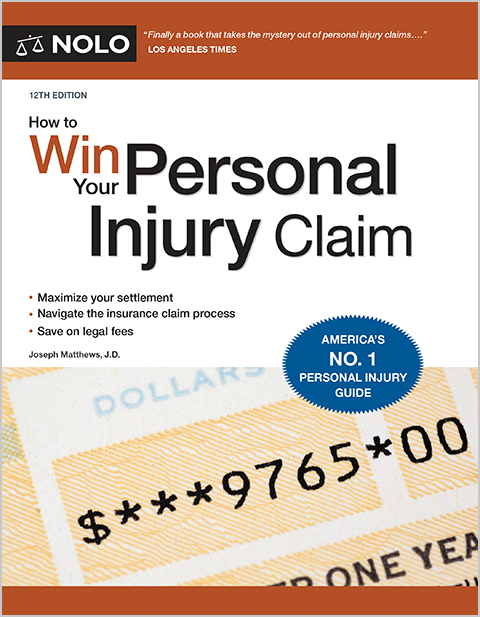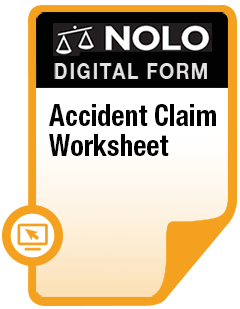Chances are the insurance company values your claim using the same tools and techniques as does your lawyer. We explain the formulas and software involved, and more.
You were injured—say in a car accident—and you filed a claim with the at-fault driver's auto insurer. Several weeks after filing your claim, you got a letter from the insurance company. The letter included a written settlement offer, one you believe is far too low. The first question that came to mind was: "How did they come up with this number?"
The personal injury claim valuation process often seems shrouded in mystery. Truth be told, though, there's no sleight-of-hand involved. When valuing claims, most insurance adjusters follow procedures similar to those used by personal injury lawyers, and place the greatest weight on the same key factors.
After a quick introduction to the world of personal injury damages, we'll pull back the curtain and explain how the process works.
What Damages Should the Insurance Company Pay For?
Figuring out how much your claim is worth means understanding two things. First, you must know what losses and expenses ("damages," in the language of the law) you're entitled to be paid for after an accident. Second, you need to know who was at fault for the accident.
Damages You Should Be Paid For
In most personal injury cases, you're entitled to collect what the law calls "compensatory damages." As the name suggests, these damages are meant to compensate you for your injuries and losses. Generally speaking, compensatory damages fall into two groups:
- economic damages, and
- noneconomic damages.
Economic damages. Also called "specials" or "special damages," economic damages reimburse you for losses and expenses that come out of your (or your insurance company's) pocket. These damages typically include:
- medical care and related expenses
- income you lose because of your injuries or treatment for your injuries
- amounts you pay for medical equipment like crutches or a walker
- the costs of replacement household services like cleaning or lawn care, and
- costs to repair or replace damaged property.
Noneconomic damages. Noneconomic damages, sometimes called "general damages," compensate you for injuries and losses that don't come directly out of your pocket. Common examples include:
- disability and disfigurement
- loss of family, social, and educational experiences, including missed school or training, vacation or recreation, or a special event
- pain and suffering, and
- emotional damages like stress, embarrassment, depression, or strains on family relationships—for example, the inability to take care of children, anxiety over the effects of an accident on an unborn child, or interference with sexual relations.
Who Was at Fault for the Accident?
In a typical personal injury case, fault for an accident gets divided up ("apportioned") among all those involved based on their share of the blame for what happened. The general rule—subject to some important exceptions—is straightforward: The party who's most at fault must pay at least some damages to parties who are less at fault.
What are the exceptions? For starters, a handful of states (Alabama, Maryland, North Carolina, and Virginia) and the District of Columbia follow a harsh, outdated rule called the "contributory negligence" rule. In these places, a party who shares any blame for an accident—even 1% of the total—is completely barred from recovering damages for their injuries.
The remaining states follow some version of the "comparative negligence" rule. A few are "pure" comparative negligence states, meaning that a person who's mostly to blame for an accident can still recover some of their damages. In a pure comparative negligence state, for instance, a party who's 99% at fault can collect 1% of their total damages.
Most states are "modified" comparative negligence states. An injured party can collect some of their damages, as long as they're not mostly (50% or 51% or more, depending on state law) to blame for the accident.
(Learn more about these shared fault rules.)
Damages Example
A quick example will illustrate. Suppose that Doe slipped and fell on Roe's icy sidewalk. Doe suffered back and neck injuries. After settlement talks with Roe's homeowner's insurer reached an impasse, the case went to court. A jury found Roe 70% at fault and assigned the remaining 30% of the blame to Doe. Jurors assessed Doe's total damages at $100,000. Let's assume the accident happened in a modified comparative negligence state.
Doe will recover 70% of $100,000, or $70,000. If the mishap had occurred in Maryland, a contributory negligence state, Doe wouldn't get any damages.
How the Insurance Company Computes Damages
While there's much more to it, an insurance company's damage calculation can be boiled down to these three steps:
- add up all economic damages
- assign a value to noneconomic damages and add them to the economic damages, and
- reduce the injured party's damages based on the state's contributory or comparative negligence rules.
Adding Up Economic Damages
There might be differences of opinion over issues like whether certain treatments were medically necessary, or whether you really needed to take six weeks off work instead of four. Your lawyer will respond to these and similar challenges from the insurance adjuster. But for the most part, figuring your total economic damages comes down to fairly simple addition. Add all the amounts you're out-of-pocket because of the accident. Those are your economic damages.
Assign a Value to Noneconomic Damages
Most of the hard claim valuation work comes here. How do you put a dollar value on, say, severe facial disfigurement? Or pain and suffering? There's no single, universally-accepted way to assign a value to these noneconomic damages. Insurance companies commonly use one (or both) of these approaches:
- a damage formula, or
- damage calculation software.
A Damage Formula
Some insurers use a multiplier formula to calculate noneconomic damages. Others might use a "per diem" formula approach. Here's how they work.
A multiplier formula. To calculate noneconomic damages using a multiplier, the adjuster starts by adding up all your medical expenses. Your noneconomic damages will be some multiple of these medical costs. For a case involving minor injuries, the multiplier might be one or two times your medical bills. More serious or longer-lasting injuries can justify a multiplier of between three and five. For cases involving particularly severe or catastrophic injuries, the multiplier might be 10 or more.
For example, suppose your car accident medical expenses total $40,000. The adjuster might decide to use a multiplier of two, yielding a figure of $80,000 for your pain and suffering, disability, and loss of enjoyment of life.
Chances are that you (or your lawyer) will choose a higher number, like four. At this multiplier, your noneconomic damages come to $160,000, leaving a gap of $80,000 between you and the insurance company. That—along with your share of the blame for the accident—is where most of the settlement negotiations will take place.
A per diem formula. Here, the adjuster simply assigns a daily ("per diem") value to your noneconomic losses, and applies it for the duration (or expected duration) of your recovery. It's common to use a number of $150 to $200 per day or, if greater, your daily salary or wage. The worse your injuries, the higher the daily rate will be.
Let's say the adjuster picks a figure of $150 per day and assumes a recovery period of two years. The calculation looks like this: $150 x 365 x 2 = $109,500. Your per diem amount is likely to be much greater. Maybe your annual salary works out to $270 each day, and you claim your recovery period should be three years. The computation is: $270 x 365 x 3 = $295,650.
A note about formulas. As you can see, there's no single "correct" formula. Both sides typically understand that their formula numbers represent an opening bid, not a final, bottom-line settlement number. The takeaway is that there almost certainly will be ample room to negotiate over the value assigned to noneconomic damages.
Damage Calculation Software
Insurance companies and adjusters have been using damage calculation software for about 30 years. The specifics of these programs are closely guarded trade secrets. What little is known about them comes from leaks by former insurance claims workers and adjusters.
By far, the most widely used program is called Colossus. Designed to calculate damages in relatively low-value car accident cases, Colossus is used (or has been used) by many of the largest insurance companies and by adjusters who handle claims for smaller insurers. If you've had a car accident insurance claim within the last 20 years or so, and if your claim was worth less than $100,000, chances are Colossus put a value on it.
In a nutshell, these programs use information about you, your lawyer, your injuries, treatment, and recovery to arrive at a case value or, more likely, a range of possible values. Adjusters usually start negotiations at or below the low end of the settlement range—more experienced adjusters might have more leeway to deviate from Colossus values.
There's only one way to (possibly) find out if an insurer has valued your case using a valuation program: Ask the adjuster. A few companies are transparent about their software use, but many are not. If the adjuster admits to having used claims software, ask them to give you the full range of claim values. You probably won't get what you're after, but it doesn't hurt to try.
Total Your Noneconomic and Economic Damages
Once the insurer has arrived at a value for your noneconomic damages, it adds that number to your total economic damages. This sum equals your total compensatory damages, according to the insurance company.
Let's assume, based on our multiplier example above, that your economic damages include $40,000 in medical bills. We'll also assume you have $10,000 in lost wages, and you paid another $5,000 for medical equipment and household replacement services. Your special damages come to $55,000.
Based on the multiplier it chose, the insurer values your noneconomic damages at $80,000. This puts your total compensatory damages at $55,000 + $80,000 = $135,000.
Reduce the Damages for Your Share of the Fault
Now, say the insurance adjuster believes that you were 45% at fault for the collision. The insurance company will probably start settlement talks with an offer of 55% of $135,000, or $74,250, to settle your claims.
If you're in a modified comparative negligence state, the adjuster might try to play hardball by claiming that you were 50% or more at fault, meaning the company would deny your claim. Should that happen, it's time to speak to an attorney about a lawsuit.
Next Steps
Insurance companies don't have some unique, magic way of valuing claims that produces correct, indisputable results. In many or most cases, they use the same methods you and your lawyer do. The difference usually comes down to matters of opinion—whether chiropractic or acupuncture treatments should be paid for, how long it took you to recover, how serious and debilitating your injuries and treatments were, and the like.
An experienced personal injury lawyer knows how insurers value different kinds of claims in your area, and can handle negotiations if you're not happy with the valuation of your case. When you're ready to move ahead, here's how to find an attorney who's right for you.


